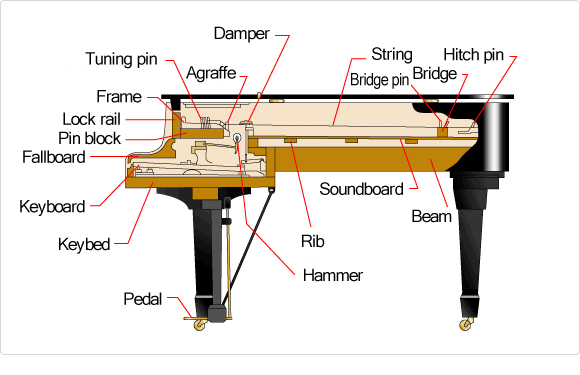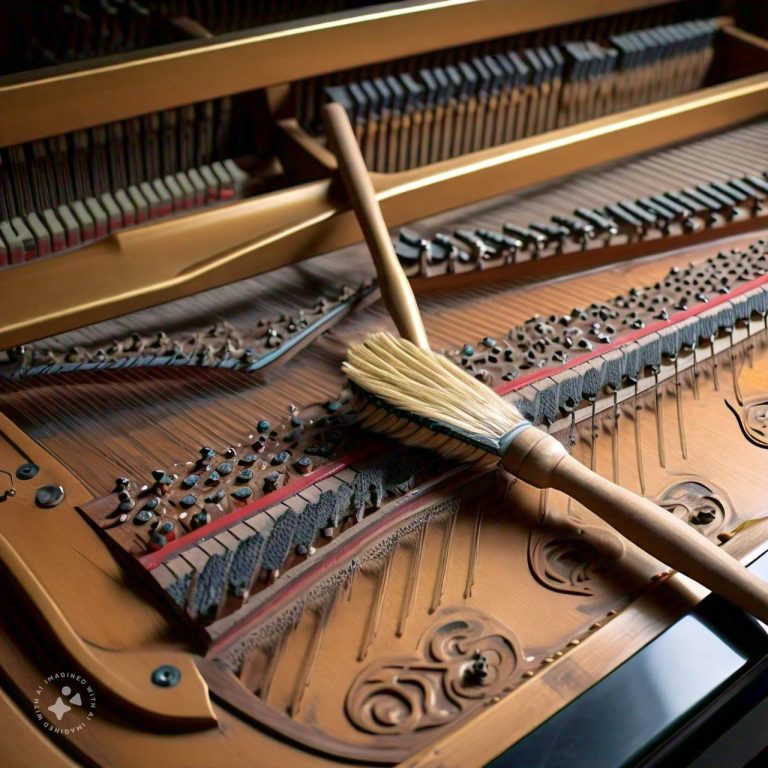A GUIDE TO PIANO PARTS
About Piano
A GUIDE TO PIANO PARTS
The standard modern piano is a symphony of parts that come together in harmony. We offer the full range of piano parts of the highest quality.
Many piano enthusiasts want a thorough understanding of how their instrument works. This can help you understand your maintenance needs so you can understand basic maintenance and when to see a technician.
Read on for a quick rundown of what goes into a grand piano.
If you would like a more in-depth study of the instrument, we have a range of technical books covering the anatomy of the piano and its maintenance.
STRUCTURE: A PIANO ANATOMY OVERVIEW

HOW PIANO KEYS WORK
White piano keys, or “natural” keys enable you to play in C major. They represent the tones A, B, C, D, E, F, and G. Black piano keys fill in the rest.
For piano keys to run smoothly, they should be cleaned at least twice per week. If you do not use your piano regularly, less maintenance may be acceptable. Remember that while you may not see it, piano keys easily gather oil, sweat, and dust.
You should regularly clean your piano keys with a soft and dry cloth. Occasionally, you should conduct a deeper clean. We recommend Cory Key-Brite and Cleaner Cloths for this purpose (see our Catalogue).
Other tips for maintaining piano keys include:
- Keeping humidity levels below 50%
- Avoiding direct sunlight
- Professional tuning at least twice per year (with regular use)
- Damaged or worn key-tops can be replaced by a qualified technician (see our Catalogue for sets of key tops – white and black).
Key pins guide and stabilise your piano key movements. Balance rail pins act as pivot points, while front rail pins keep the front of the key stable and guide the key’s movements.
Over time, key pins can deteriorate due to:
- Dust and debris
- Lack of lubrication
- Wear and tear (primarily bending)
- Humidity
We offer balance rail and front rail key pins, as well as the lubricants they need to remain in good working condition.
We also stock keyboard locks and clamps for situations where access to the keyboard needs to be restricted (schools, restaurants, etc.) and fallboard soft-closures to protect little fingers when children grab the fallboard, music desk or music holders.
How many white keys are on a piano?
There are 52 white keys on a standard piano.
How many black keys are on a piano?
There are 36 black keys on a standard piano.
PIANO HAMMERS
A piano hammer is the part of the piano action mechanism that produces the music. The quality of your hammers is responsible for the sound quality it produces. It’s a simple mechanism:
- The piano key is pressed
- The action mechanism lifts the hammer
- The hammer hits the string, producing a sound
- The hammer rebounds to the resting position once released
Over time and with repeated use, piano hammers can become worn. As the hammer becomes compacted, it starts to affect the key’s tone. To ensure these piano parts produce the right note you must:
- Voice (or harden) the hammers to produce the most pleasing tone
- Align your hammers to strike evenly
- Reshape deformed hammer heads
- Replace broken heads
- Clean and adjust the hammer rail
What are piano hammers made of?
Piano hammers are made from a wooden moulding covered in compressed felt. The felt can be needled (voiced) or hardened by your technician to produce the most pleasing tone and volume.
PIANO STRINGS
Pianos are stringed instruments, but the strings are under a great deal more tension than other stringed instruments.
Vibrating strings are the result of a hammer striking the string. The string vibrations then travel through the bridges into the soundboard, producing music. The pitch then relies on the length, thickness, and tension of the string.
Piano stringing should be conducted with quality high-carbon steel to remain strong and durable. All our piano strings are made with top-quality German steel and copper wire. We offer custom bass string-making (full or partial sets and individual strings) and all the stringing accessories needed to maintain standard grand or upright pianos.
BASS STRINGS
Piano bass strings enable bass notes. Unlike strings for tenor and treble notes, they are made of wound copper wire instead of bare, unbound wire.
PIANO STRING MAINTENANCE
Piano strings need to be tuned at least twice per year with regular use. They need to be inspected from time to time for wear and tear. This is because over time, with or without use, they may be subject to:
- Wear
- Discoloration
- Rust
- Dust & debris
- Corrosion (copper)
- Humidity
If left to deteriorate for too long, piano strings may produce buzzing, unnatural sounds. They may then deteriorate further, producing unpleasant sounds or breaking. In these cases, string replacement is required.
We specialise in the manufacture of piano bass strings. We make full sets, partial sets and odd strings for every make and model of piano. We have a vast catalogue of stringing scales, and often require no samples – just the make and model of piano.
HOW PIANO SOUNDBOARDS WORK
Your piano soundboard is the sound-producing mechanism. It’s a complex instrument on its own requiring several materials and tailored maintenance tools. We offer the soundboard brushes, buttons, shimming tools, and steel needed for transmitting sounds into beautiful music.
Once the strings are struck as a key is pressed, the vibration moves through the bridge. Through there, the vibrations enter the soundboard. A loud sound comes out, with the vibrational character of the piano exiting into the open air. The entire piano vibrates with each pressed key, with the soundboard being the notable, sound-producing end of each vibration’s journey.
Soundboards are composed of multiple materials. Most of it is comprised of multiple layers of wood (spruce) stuck together. Spruce is a lightweight and flexible wood that enables the quick transmission of sound that you hear when pianos are played.
SOUNDBOARD MAINTENANCE

As with every part of the piano, soundboard components are vulnerable to damage caused by humidity, debris, and wear. That’s why regular maintenance checks and a good soundboard duster are so important. You should not just use any brush.
Be sure to sweep dust and debris off your soundboard during the recommended bi-annual cleaning sessions. Pay special attention to the pin blocks.
PIANO PEDALS
Most pianos come with three pedals, with some older acoustic pianos having just two. Advanced playing requires skill, not to mention well-maintained pedals. Some people also use products like piano pedal extenders for easier access.
SOFT PEDAL
Your soft pedal is on the far left and shifts the action mechanism to move the hammers closer to the strings. This way, the hammers do not hit the string as hard. This produces a much softer sound with each press.
SUSTAIN PEDAL
Sustain pedals (on the right) “sustain” the note you are playing while pressed. The mechanism lifts the damper off each string, so they vibrate without interruption. Even after you release the key, the vibration is sustained.
SOSTENUTO PEDAL
The Sostenuto pedal is the middle pedal. It serves a similar purpose to the sustain pedal. It holds onto the notes being played. However, any notes played after the pedal is pressed are not affected. This makes it a “selective” sustaining pedal.
PEDAL MAINTENANCE
For pedal mechanisms to work, the pedal’s felt pads need to be maintained. Wear and tear can hinder the pedal action, resulting in inadequate quieting. If this goes on for too long, you’ll need to replace them.
You can largely tell whether your felts are deteriorating by ear. But in any case, regular maintenance should include your pedals.
We stock a range of piano pedals, felts and accessories.
PIANO FRAME
A piano frame is also known as a “plate” or “harp”. Its purpose is to provide the structural integrity that makes everything else we’ve covered possible. In particular, the frame must be able to withstand the tension exerted by the strings.
- Rim
- Lid
- Bridges
- Pinblock
- Struts
Piano frame accessories can be subjected to all kinds of deterioration. Wear, tear, loosening, corrosion, cracks, and other potential problems need to be investigated during regular maintenance.
Our catalogue includes piano lid hinges, castors and castor cups, upright and grand dollies, tuning pins, bridge pins, and other components.
PIANO TUNING TOOLS
Piano tuning is not as straightforward as tuning other instruments.
Piano tuning, repair and maintenance is a very specialised profession. You can find a professionally qualified tuner close to you from the Australian Piano Tuners and Technicians Guild website.
We stock a full range of quality piano tuning and regulating tools.
These include tuning tools, such as tuning hammers (tuning levers), mutes and wedges, tuning forks and muting strips; regulating tools , such as regulating screwdrivers, voicing tools, damper regulators, key spacers, spoon and wire benders, capstan tools, flange spacers and drop screw regulators, centre pin removers and reamers and regulating pliers; and stringing tools, such as tuning pin punches, coil makers, coil setters, stringing hooks, spacers and lifters and looping machines.
PIANO FELT AND LEATHER
Piano felt and leather parts are crucial for action regulation, tone, and damper quality.
Felts are used in the dampers so that your strings stop vibrating when you release your keys. Our high-quality dampers and damper felts ensure that the effect is precise, stopping unwanted vibrations. Lastly, felt quality is important in action regulation, ensuring each movement is smooth and consistent.
Piano leathers play similar parts, with your leather quality largely determining the quality and longevity of the action mechanism.
MAINTENANCE TOOLS
Pianos require several polishes, lubricants, and adhesives to maintain their appearance and functionality.
The best piano cleaner and polish products clean and protect your piano’s structure without causing damage. That’s why we offer a selection of maintenance products that are safe on the delicate surfaces they were made for.
The quality level of these maintenance products is as important as the quality of your piano’s mechanical components. They ensure aesthetic consistency as well as durability.
